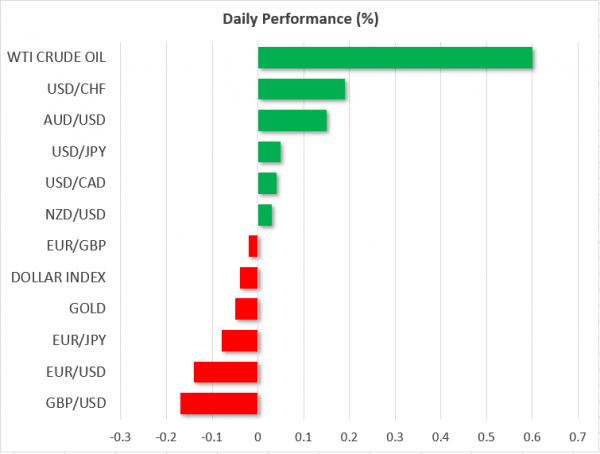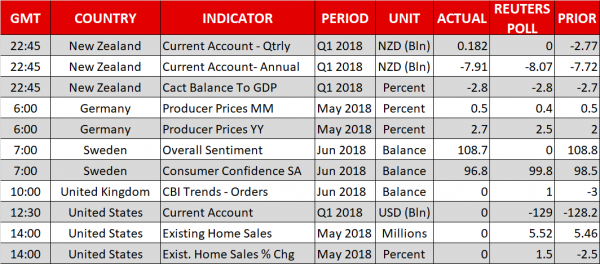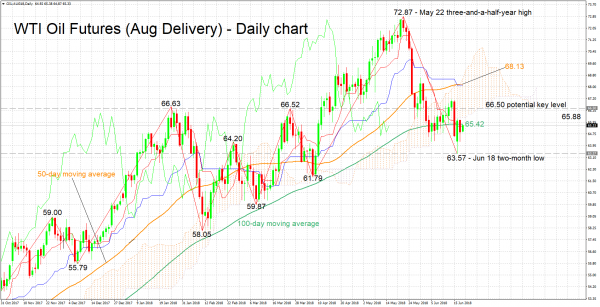Here are the latest developments in global markets:
FOREX: The US dollar index is lower on Wednesday, though by less than 0.1%, giving back some of the gains it posted in the previous session as the currency with the most weight in the index – the euro – tumbled. The haven-perceived yen is also on the retreat, paring some of the gains it posted yesterday.
STOCKS: Wall Street closed lower on Tuesday, amid fears over an escalating US-China trade spat and its potential repercussions. The Dow Jones led the way lower, tumbling by 1.15%, while the S&P 500 and the Nasdaq Composite fell by 0.40% and 0.28% respectively, both paring a significant chunk of their earlier losses before the closing bell. Today may be different though, as futures tracking the Dow, S&P, and Nasdaq 100 are all signaling a higher open. The same was true in Asia, with some dovish comments from the PBOC supporting risk appetite. Japan’s Nikkei 225 and Topix climbed by 1.24% and 0.51% correspondingly, while in Hong Kong, the Hang Seng rose 0.82%. In Europe, futures following all the major indices were a sea of green as well, pointing to a higher open today.
COMMODITIES: Oil prices are higher on Wednesday, buoyed by expectations that the OPEC meeting on Friday may not end up delivering a material increase in production. Iran reiterated yesterday that it will not support any increase in output, a position shared by Venezuela and Algeria, setting the stage for a showdown between those producers and OPEC’s de-facto leader, Saudi Arabia. Any OPEC decision needs to be unanimous, and it increasingly appears this will not be the case this time. In precious metals, gold is marginally lower today, extending losses from Tuesday. The yellow metal has remained impervious to escalating trade tensions, a rather bizarre development considering the heightened uncertainty in markets. A reasonable explanation is that a stronger dollar is exerting downward pressure on prices, and that investors may be tactically selling gold to cover losses in riskier assets, such as equities.
Major movers: Risk sentiment recovers somewhat; euro softens after Draghi
The risk-off tone that characterized price action on Tuesday, amid an escalating trade spat between the US and China, seems to have eased on Wednesday. Haven assets such as the yen are trading a little lower, giving back some of the gains they posted in the previous session, while risk-sensitive currencies like the aussie and the kiwi are on the rebound. Meanwhile, although US stock markets closed lower yesterday, Asian indices are higher today, reflecting that the pessimism has been “put on hold for now” (to paraphrase the US Treasury Secretary).
Given the absence of any major news on the trade front, the trigger for the shift in sentiment appears to have been some market-friendly signals from the People’s Bank of China (PBOC). The central bank said it is prepared for outside shocks and that China has room to face all sorts of trade frictions, fueling speculation for a loosening of policy should the trade outlook deteriorate. Ironically, any further easing from the PBOC could lead to a weaker yuan, thereby exacerbating the US-China trade deficit that the US administration is so desperately trying to reduce.
The euro came under renewed selling interest yesterday, following some remarks from ECB President Draghi, who reinforced expectations that a hike may only come after the summer of 2019. Looking at market pricing, investors seem to have digested the message. The Bank is currently expected to push the rate-hike button in Q4 2019, when it is anticipated to hike rates by a modest 10bps.
In the UK, Brexit remains front and center. The Government said yesterday it “cannot accept” a Lords amendment giving Parliament a meaningful vote on the final Brexit deal. The administration will reframe its rejected version of the bill and put it for another vote this week. Broadly speaking, anything that gives Parliament a greater say over Brexit is considered positive for sterling. Thus, the outcome of the vote could set the tone for the pound’s direction over the remained of the week, especially given the absence of tier-one UK data.
Elsewhere, the Canadian dollar continued to lose ground on Tuesday, touching a fresh one-year low against its US counterpart. With little in the way of news or data out of Canada lately, the plunge appears to be owed more to fluctuations in oil prices, as well as the broader risk-aversion in markets seen yesterday clouding the outlook for commodity currencies like the loonie. Similarly, while aussie/dollar is in recovery-mode today, it touched a one-year low on Tuesday as well.
Day ahead: House of Commons vote, global trade developments and ECB Forum panel discussion in focus; US existing home sales and current account data due
Existing home sales and current account data out of the US are the releases generating most interest out of Wednesday’s calendar. A House of Commons vote on Brexit amendments that has the potential to put PM Theresa May’s position in jeopardy, as well as the ongoing trade spat between the US and China will be taking priority over today’s releases though. Meanwhile, a panel discussion featuring the heads of the ECB and the Federal Reserve will also be in focus.
At 1000 GMT, the Confederation of British Industry’s gauge of order books pertaining to factory output is expected to return to positive territory at +1, after falling to -3 in May, its lowest level since November 2016.
In the US, current account data for Q1 due at 1230 GMT are anticipated to show the deficit widening to $129.0 billion from $128.2bn in Q4. Later (1400 GMT), the country’s existing home sales for May are projected to have risen by 1.5% m/m, after declining by 2.5% in April.
Sterling is expected to be sensitive to a House of Commons vote that may cast fresh doubts on PM May’s leadership, adding a layer of uncertainty over the UK; a clash between Theresa May and pro-EU “fellow” Conservatives over her Brexit plans might play out today.
Escalating US-China trade tensions that have weighed on global equity markets on Tuesday will also be closely monitored during today’s trading.
The EIA’s weekly report on crude oil inventories due at 1430 GMT might offer some short-term direction to oil prices ahead of the upcoming two-day OPEC meeting in Vienna commencing on June 22. Crude stocks are projected to have declined by around 1.9 million barrels during the week ending June 15, after falling by around 4.1m in the previously tracked week.
Among policymakers making appearances are ECB President Mario Draghi, Fed Chairman Jerome Powell, Bank of Japan Governor Haruhiko Kuroda and Reserve Bank of Australia Governor Philip Lowe. They will all be participating in an eagerly-awaited panel discussion on central bank policy at the ECB Forum in Sintra, Portugal at 1330 GMT. In the meantime, a report on the eurozone economy presented by the governor of the Bank of France at 0730 GMT might attract interest.
In the meantime, North Korea’s Kim Jong Un will be completing his two-day visit to Beijing.
Technical Analysis: WTI oil futures bearish bias eases
WTI oil futures (August delivery) have managed to recover from Monday’s two-month low of 63.57. Still, the short-term bias remains to the downside as evidenced by the Tenkan-sen which is below the Kijun-sen line and following a notable decline from a three-and-a-half-year high of 72.87 in late May. The bearish momentum has eased though, with the flat Kijun-sen also attesting to this.
If today’s EIA report shows a larger-than-anticipated drawdown in crude inventories, then prices could move higher. The area around the current level of the 100-day moving average at 65.42 seems to be providing immediate resistance to advances. The Tenkan-sen (65.25) which was violated earlier in the day and the Ichimoku cloud bottom (65.88) are also part of the region around the 100-day MA. Further above, the range around 66.50, which encapsulates a couple of peaks from previous months, may be of significance.
On the downside and in case of a smaller-than-expected drawdown in crude stocks (or a buildup) that pushes prices down, support could be provided around 64.20, this being a previous top. Steeper losses would shift the focus to Monday’s two-month low of 63.57 for additional support.
















